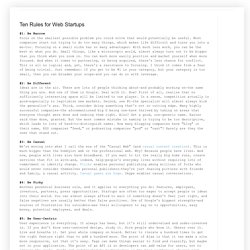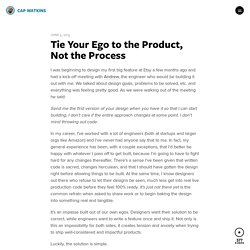

Mistakes That Kill Startups, The Reality Of VC, Internal Startup Tools To Grow, Product Management Ego, Superstar Programmers, Tough CEOs. I Got 99 Problems But My Pitch Ain’t One. This Startup Built Internal Tools to Fuel Major Growth — Here’s Their Approach. The new reality of venture capital. Disconnect between value creation and capture The venture capital industry creates value that far outweighs the dollars allocated to it.

But ten year returns to investors haven’t reflected that fact. Innovation presents opportunities to solve customer problems more effectively and efficiently. But creating solutions that don’t yet exist involves a high degree of uncertainty. Usually, you need to spend a considerable amount of time and money before you know your efforts are going to pan out. Source: PricewaterhouseCoopers/National Venture Capital Association Venture Capital is one of the most important sources of risk capital around.
Yet that 0.2% has been key in creating companies that account for 21% of the US GDP, and over 11% of private sector jobs (read the report). Of course, venture financing isn’t the only funding source most of these successful companies have used to get where they are. But where is the payback for investors? Ten years is a pretty long time. A rising tide. The Programmer’s Price. Not long ago, Stephen Bradley, a New York tech entrepreneur, was looking to expand his company, AuthorBee, which aggregates tweets and Instagram posts and puts them together in story form.

Instead of following people, readers can follow their interests—“Breaking Bad,” for example, or the New England Patriots. Bradley is not a stereotypical startup founder, a hoodie-wearing college dropout; he’s been working in tech and media for decades. Why Entrepreneurs Should Be Respected More Than Loved. One of the vivid memories I have from being a startup CEO is the feeling that most people in your company have a look in their eyes that like they can do your job as well as you.

How hard could it be? You just assign out tasks to all of us. In the early days the CEO is the jack-of-all-trades, doer-of-all, famously the “chief janitor” or coffee maker. But if you level up, raise capital and grow customers, revenue and staff – life changes. Eventually you need a VP of Product to handle your product roadmap, a CTO for engineering leadership and VPs of sales, marketing & biz dev. This is when your job function truly starts to match the definition of “leader” because that’s exactly what your role is. Leadership is actually quite difficult. If you hire truly talented people you end up definitionally with a lot of competitive peers who will inevitably jockey for resources and control. Marketing of course often feels the opposite.
And then there’s product management. Engineering? Ten Rules for Web Startups. #1: Be NarrowFocus on the smallest possible problem you could solve that would potentially be useful.

Most companies start out trying to do too many things, which makes life difficult and turns you into a me-too. Focusing on a small niche has so many advantages: With much less work, you can be the best at what you do. Small things, like a microscopic world, almost always turn out to be bigger than you think when you zoom in. You can much more easily position and market yourself when more focused. And when it comes to partnering, or being acquired, there's less chance for conflict. . #2: Be DifferentIdeas are in the air. . #3: Be CasualWe're moving into what I call the era of the "Casual Web" (and casual content creation)
. #4: Be PickyAnother perennial business rule, and it applies to everything you do: features, employees, investors, partners, press opportunities. . #5: Be User-CentricUser experience is everything. . #7: Be GreedyIt's always good to have options. . #11 (bonus!) The 18 Mistakes That Kill Startups.
October 2006 In the Q & A period after a recent talk, someone asked what made startups fail.

After standing there gaping for a few seconds I realized this was kind of a trick question. It's equivalent to asking how to make a startup succeed—if you avoid every cause of failure, you succeed—and that's too big a question to answer on the fly. Afterwards I realized it could be helpful to look at the problem from this direction. If you have a list of all the things you shouldn't do, you can turn that into a recipe for succeeding just by negating. In a sense there's just one mistake that kills startups: not making something users want. Tie Your Ego to the Product, Not the Process. I was beginning to design my first big feature at Etsy a few months ago and had a kick-off meeting with Andrew, the engineer who would be building it out with me.

We talked about design goals, problems to be solved, etc. and everything was feeling pretty good. As we were walking out of the meeting he said: